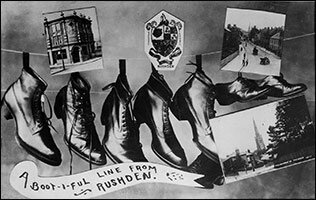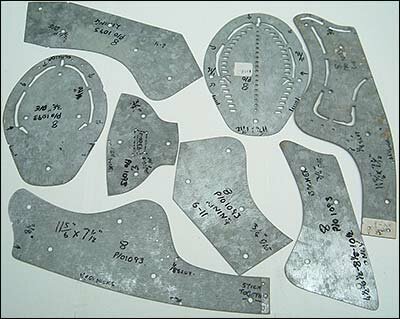|
|
|||||||
|
Shoetrade - Overview
|
|||||||
|
|||||||
|
Until the 18th century shoe making was very much a local trade, with leather tanned in the villages that were near to water. Here in Rushden the early tan pits were to the south of the village near the brook. The village shoemakers would have sold their wares within the village and any surplus was taken to the markets at Higham Ferrers or Wellingborough.
Engineers were meeting the challenge to invent machinery to do some of the work, starting with presses for cutting the leather. The sole presses came first, then the “Blake Sewer” for the heavy sole stitching. Machinery, being heavy, was static, so the men were brought into the building to work rather than working alone in their “shop” in the yard behind the house. Instead of delivering the work to their employees the entrepreneurs drew the men into their manufactory and the whole trade became more orderly. Work was organised into cutting, stitching and finishing. More machines were invented to do the other sewing tasks, then for most of the other operations; riveting, eyeleting, trimming. The factories were growing in size and in the early 1900s trade expanded quickly with some large government contracts to supply army boots. Women began to do some of the lighter work, mainly sewing the uppers or “closing” and as trade expanded more, the lighter machines for this could be used in the home and “outdoor” work was once again introduced. Some of the local factory owners took their employees on “annual outings” to a neighbouring village where they would be served tea and enjoy the sights of another place. With further expansion, so the factory owners organised more adventurous trips for their employees. In the mid 1940s John White took four trains carrying all his employees to London. He also gave them a packed lunch and a booklet with a map to tell them something about the capital city and organised an entertainment for them, at one of the theatres. The boom years for the trade were in the mid 1900s, but then foreign imports started to come, at first from Italy, then from the eastern countries and gradually one by one, the factories were closed down. By 1990 the majority had gone and today there are just four companies still shoemaking in our town. (2007)
a shoemakers workshop |
|||||||



